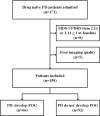Baseline cerebral structural morphology predict freezing of gait in early drug-naïve Parkinson's disease
- PMID: 36581626
- PMCID: PMC9800563
- DOI: 10.1038/s41531-022-00442-4
Baseline cerebral structural morphology predict freezing of gait in early drug-naïve Parkinson's disease
Abstract
Freezing of gait (FOG) greatly impacts the daily life of patients with Parkinson's disease (PD). However, predictors of FOG in early PD are limited. Moreover, recent neuroimaging evidence of cerebral morphological alterations in PD is heterogeneous. We aimed to develop a model that could predict the occurrence of FOG using machine learning, collaborating with clinical, laboratory, and cerebral structural imaging information of early drug-naïve PD and investigate alterations in cerebral morphology in early PD. Data from 73 healthy controls (HCs) and 158 early drug-naïve PD patients at baseline were obtained from the Parkinson's Progression Markers Initiative cohort. The CIVET pipeline was used to generate structural morphological features with T1-weighted imaging (T1WI). Five machine learning algorithms were calculated to assess the predictive performance of future FOG in early PD during a 5-year follow-up period. We found that models trained with structural morphological features showed fair to good performance (accuracy range, 0.67-0.73). Performance improved when clinical and laboratory data was added (accuracy range, 0.71-0.78). For machine learning algorithms, elastic net-support vector machine models (accuracy range, 0.69-0.78) performed the best. The main features used to predict FOG based on elastic net-support vector machine models were the structural morphological features that were mainly distributed in the left cerebrum. Moreover, the bilateral olfactory cortex (OLF) showed a significantly higher surface area in PD patients than in HCs. Overall, we found that T1WI morphometric markers helped predict future FOG occurrence in patients with early drug-naïve PD at the individual level. The OLF exhibits predominantly cortical expansion in early PD.
© 2022. The Author(s).
Conflict of interest statement
The authors declare no competing interests.
Figures



Similar articles
-
Cortical thickness and white matter microstructure predict freezing of gait development in Parkinson's disease.NPJ Parkinsons Dis. 2024 Jan 9;10(1):16. doi: 10.1038/s41531-024-00629-x. NPJ Parkinsons Dis. 2024. PMID: 38195780 Free PMC article.
-
Alterations of structure and functional connectivity of visual brain network in patients with freezing of gait in Parkinson's disease.Front Aging Neurosci. 2022 Sep 7;14:978976. doi: 10.3389/fnagi.2022.978976. eCollection 2022. Front Aging Neurosci. 2022. PMID: 36158540 Free PMC article.
-
Constructing Prediction Models for Freezing of Gait by Nomogram and Machine Learning: A Longitudinal Study.Front Neurol. 2021 Dec 6;12:684044. doi: 10.3389/fneur.2021.684044. eCollection 2021. Front Neurol. 2021. PMID: 34938251 Free PMC article.
-
Cerebral blood flow alterations specific to freezing of gait in Parkinson's disease.Neurol Sci. 2022 Sep;43(9):5323-5331. doi: 10.1007/s10072-022-06205-6. Epub 2022 Jun 20. Neurol Sci. 2022. PMID: 35725857
-
Impaired Topographical Organization of Functional Brain Networks in Parkinson's Disease Patients With Freezing of Gait.Front Aging Neurosci. 2020 Oct 21;12:580564. doi: 10.3389/fnagi.2020.580564. eCollection 2020. Front Aging Neurosci. 2020. PMID: 33192473 Free PMC article.
Cited by
-
Atrophy of ventral diencephalon is associated with freezing of gait in Parkinson's disease: analysis of two cohorts.NPJ Parkinsons Dis. 2025 Mar 6;11(1):44. doi: 10.1038/s41531-025-00893-5. NPJ Parkinsons Dis. 2025. PMID: 40050652 Free PMC article.
-
Houston, We Have AI Problem! Quality Issues with Neuroimaging-Based Artificial Intelligence in Parkinson's Disease: A Systematic Review.Mov Disord. 2024 Dec;39(12):2130-2143. doi: 10.1002/mds.30002. Epub 2024 Sep 5. Mov Disord. 2024. PMID: 39235364 Free PMC article.
-
A meta-analysis identifies factors predicting the future development of freezing of gait in Parkinson's disease.NPJ Parkinsons Dis. 2023 Dec 4;9(1):158. doi: 10.1038/s41531-023-00600-2. NPJ Parkinsons Dis. 2023. PMID: 38049430 Free PMC article. Review.
-
Reorganization of gray matter networks in patients with Moyamoya disease.Sci Rep. 2025 Jan 22;15(1):2788. doi: 10.1038/s41598-025-86553-3. Sci Rep. 2025. PMID: 39843464 Free PMC article.
-
Abnormal functional connectivity density involvement in freezing of gait and its application for subtyping Parkinson's disease.Brain Imaging Behav. 2023 Aug;17(4):375-385. doi: 10.1007/s11682-023-00765-7. Epub 2023 May 27. Brain Imaging Behav. 2023. PMID: 37243751
References
Grants and funding
- 2021A1515011288/Natural Science Foundation of Guangdong Province (Guangdong Natural Science Foundation)
- 202102010020/Guangzhou Municipal Science and Technology Project
- 82001908/National Natural Science Foundation of China (National Science Foundation of China)
- 2021T140065/China Postdoctoral Science Foundation
- Z191100001119023/Beijing Nova Program
LinkOut - more resources
Full Text Sources

